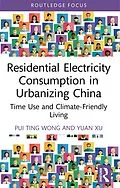This book forges a link between residential CO2 emissions and time use, focussing on China as a key case study.
To provide a better understanding of the energy implications of the lifestyle differences between urban and rural China, Pui Ting Wong and Yuan Xu utilise time-use methodology as an alternative way to explore the links between individual lifestyle and residential electricity consumption. They begin by examining how Chinese citizens divide their time between daily activities, highlighting patterns around indicators including age, gender, education, and economic status. They go on to quantify CO2 intensities of these time-use activities. Through this linkage, this book presents an alternative strategy for climate-friendly living, highlighting the ways in which urban planning can be deployed to help individuals adapt their time-use patterns for CO2 mitigation.
Providing a novel contribution to the growing literature on residential electricity consumption, Residential Electricity Consumption in Urbanizing China will be of great interest to scholars of climate policy, energy studies, time use, and urban planning.
Autorentext
Pui Ting Wong is a Ph.D. student in the Rachel Carson Center for Environment and Society, LMU Munich, Germany.
Yuan Xu is an Associate Professor in the Department of Geography and Resource Management at the Chinese University of Hong Kong. He is also leading the Environmental Policy and Governance Programme in the Institute of Environment, Energy, and Sustainability.
Klappentext
This book forges a link between residential CO2 emissions and time use, focussing on China as a key case study.
To provide a better understanding of the energy implications of the lifestyle differences between urban and rural China, Pui Ting Wong and Yuan Xu utilise time use methodology as an alternative way to explore the links between individual lifestyle and residential electricity consumption. They begin by examining how Chinese citizens divide their time between daily activities, highlighting patterns around indicators including age, gender, education, and economic status. They go on to quantify CO2 intensities of these time-use activities. Through this linkage, this book presents an alternative strategy for climate-friendly living, highlighting the ways in which urban planning can be deployed to help individuals adapt their time use patterns for CO2 mitigation.
Providing a novel contribution to the growing literature on residential electricity consumption, Residential Electricity Consumption in Urbanizing China will be of great interest to scholars of climate policy, energy studies, time use and urban planning.
Inhalt
Contents
Chapter 1 Introduction
1. Climate change and China's residential sector
2. Lifestyle and residential energy consumption
2.1. Residential energy consumption
2.2. Urbanization and residential energy consumption
2.3. Demographic change and residential energy consumption
3. Time Use as a residential lifestyle indicator
3.1. Time-use survey and applications
3.2. Time use and energy consumption
4. Objectives and outline
Chapter 2 Time use in evolving China
1. The Chinese Time Use Survey (CTUS)
2. Time-use-defined lifestyles in China
Chapter 3 Estimating residential electricity and CO2 intensity of time-use activity
1. Estimating energy intensity of time use
2. A bottom-up approach for constructing electricity intensity
2.1. Matching electric appliances with activities
2.2. Electricity intensity
3. Data
3.1. The Chinese residential energy consumption survey (CRECS)
3.2. Mending the mismatched datasets
4. Changes between 2008 and 2018
4.1. Appliance characteristics in 2008 and 2018
4.2. Sharing characteristics in 2008 and 2018
4.3. Reconstructed intensity of activity in 2008 and 2018
Chapter 4. Residential CO2 emissions of lifestyles
1. Reconstructing residential CO2 emissions
2. Residential CO2 emissions by activities
3. Discussion
Chapter 5 The climate impacts of lifestyles from demographic changes
1. China's demographic shifts
2. Climate impacts of the major ongoing demographic shifts in China
3. Climate impacts of time-use patterns
4. Climate impacts of time-use management
Chapter 6 Time use management for carbon mitigation
Index
